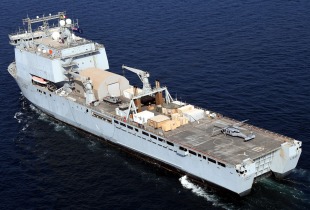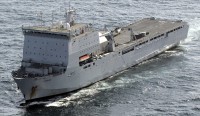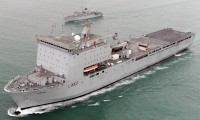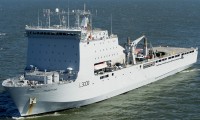Bay-class landing ship
Basic information
Ship measurements
Machine
- 2 * Wärtsilä 8L26 generators, 6,000 hp (4.5 MW)
- 2 * Wärtsilä 12V26 generators, 9,000 hp (6.7 MW)
- 2 * azimuthing thrusters
- 1 * bow thruster
Personnel
Combat assets
- 1,150 linear metres of vehicles (up to 24 Challenger 2 tanks or 150 light trucks)
- Cargo capacity of 200 tons ammunition or 24 TEU containers
- 1 * LCU or 2 * LCVP in well deck
- 2 * Mexeflote powered rafts
- Fitted for:
- 2 * DS30B Mk 1 30 mm guns
- 2 * Phalanx CIWS
- 4 * 7.62mm Mk44 Miniguns (maybe replaced by Browning .50 caliber heavy machine guns as of 2023)
- 6 * 7.62mm L7 GPMG
- Aviation facilities
- Flight deck for helicopters up to Chinook-size; temporary hangar can be fitted
The Bay class is a ship class of four dock landing ships built for the British Royal Fleet Auxiliary (RFA) during the 2000s. These vessels are constructed based on the Dutch-Spanish Royal Schelde Enforcer blueprint and serve as replacements for the Round Table-class supply ships. Swan Hunter and BAE Systems Naval Ships were each tasked with building two ships. Commencing in 2002, construction experienced significant setbacks and financial excesses, particularly at Swan Hunter's facilities. By mid-2006, Swan Hunter was relieved of its duties, and the partially finished second ship was transferred to BAE's shipyard for completion. All four vessels — Largs Bay, Lyme Bay, Mounts Bay, and Cardigan Bay — were operational by 2007.
Since becoming operational, the Bay-class vessels have been employed in amphibious activities, training missions for the Iraqi Navy in the Persian Gulf, anti-narcotic operations in the Caribbean, and humanitarian efforts following the 2010 Haiti earthquake. In 2010, Largs Bay was decommissioned as part of the Strategic Defence and Security Review and sold to the Royal Australian Navy (RAN) in 2011, where it operates under the name HMAS Choules.
The Bay class was developed to replace the five Round Table-class supply ships operated by the RFA. Planning for this class began in the 1990s after attempts to modernize and extend the service life of three Round Tables were hindered by extensive corrosion and challenges in implementing new safety standards. Following the tardy return to service of the first Round Table, coupled with exorbitant costs, the Ministry of Defence initiated discussions regarding the acquisition of new vessels.
In April 2000, the MoD issued an Invitation to Tender for two ships within a budget of £150 million, with the option to procure three additional ships. Appledore Shipbuilders, BAE Systems Naval Ships, and Swan Hunter submitted tenders, but only Swan Hunter's design met all the criteria, priced at £148 million. Concerns arose about a shortage of work at BAE's Govan yard, potentially impeding the delivery of the Type 45 destroyers and Queen Elizabeth-class aircraft carriers planned for later in the decade. Consequently, the Treasury approved funding for two additional LSDs to be constructed at Govan.
The contract for Largs Bay and Lyme Bay was awarded to Swan Hunter on December 18, 2000, while BAE secured the £122 million contract for Mounts Bay and Cardigan Bay on November 19, 2001. Construction of Largs Bay commenced at Swan Hunter on January 28, 2002, and Mounts Bay at BAE on August 25, 2002.
Swan Hunter faced challenges in project management and cost containment, with only 7% of the design drawings provided on schedule, and over 52% delayed by more than a year. Swan Hunter's owner, Jaap Kroese, attributed the difficulties to the MoD's consistent alterations to the specifications. The extent of the issues became apparent in September 2003 when Swan Hunter announced its inability to fulfill the contract at the agreed-upon price. Progress on Largs Bay was further impeded in November 2004 when water infiltrated two engines during trials, delaying the delivery of the lead vessel behind BAE's first ship.
Mounts Bay entered service in July 2006, followed by Largs Bay in November of the same year, a delay of 28 months from the original schedule. The unfinished Lyme Bay was transported to Govan for completion by BAE. Lyme Bay was commissioned on November 26, 2007, marking the conclusion of shipbuilding on the Tyne. It was the only warship built by Swan Hunter but left incomplete. Shortly thereafter, Swan Hunter sold its equipment to India and transitioned into an engineering consultancy firm.
The Bay class holds certification as a class 1 passenger ship, bearing design resemblances to ro-pax ferries. It is modeled after the Royal Schelde Enforcer, a collaborative effort between the Dutch and Spanish resulting in the Rotterdam-class and Galicia-class amphibious warfare vessels. Notably, the British variants lack a helicopter hangar. Originally designated as Auxiliary Landing Ship Logistics (ALSL), the nomenclature was altered in 2002 to Landing Ship Dock (Auxiliary) (LSD(A)), better aligning with their operational role and NATO's designation for the Royal Schelde vessels.
Each Bay-class ship boasts a full load displacement of 16,160 tonnes, measuring 176.6 meters in length, with a beam of 26.4 meters and a draught of 19 feet (5.8 meters). Propulsion is supplied by two Wärtsilä 8L26 generators, producing 6,000 horsepower (4.5 MW), and two Wärtsilä 12V26 generators, generating 9,000 horsepower (6.7 MW). These power two steerable azimuthing thrusters, complemented by a bow thruster. The maximum speed is 18 knots (33 km/h; 21 mph), and the ships have a range of 8,000 nautical miles (15,000 km; 9,200 mi) at 15 knots (28 km/h; 17 mph). Armament consists of two Phalanx CIWS, two manual 30 mm DS30B cannons, and various small arms, although the exact weaponry may vary within the class.
During British service, the standard ship's complement ranged from 60 to 70 RFA personnel, supplemented by members of the British Armed Forces during operational deployments. For instance, during Largs Bay's mission in response to the 2010 Haiti earthquake, the vessel sailed with a core crew of 70, along with 40 Royal Logistic Corps personnel for boat- and cargo-handling duties, and 17 individuals from the Royal Navy and Royal Marines for security-related tasks. Choules, operated by Australia, maintains a permanent crew of 158, including a Ship's Army Department of 22.
Functioning as a sealift vessel, each Bay-class ship has the capacity to transport up to 24 Challenger 2 tanks or 150 light trucks in 1,150 linear meters of space, accessible via stern- and side-ramp entry to the vehicle deck. The cargo hold can accommodate up to 200 tons of ammunition or 24 twenty-foot equivalent unit containers. Under normal conditions, a Bay-class ship can carry 356 soldiers, which can nearly double to 700 under overload conditions. The flight deck accommodates helicopters up to the size of Chinooks, along with Merlin helicopters and Osprey tiltrotor aircraft. Although lacking a long-term helicopter hangar, temporary shelter can be fitted to house a Merlin or smaller helicopter. Additionally, the well dock can accommodate one LCU Mark 10 or two LCVPs, while two Mexeflotes can be suspended from the ship's flanks. Two 30-ton cranes are situated between the superstructure and the flight deck, with internal passages wide enough for two fully equipped marines to pass each other.
Ships4
- Comments
 en
en ru
ru uk
uk





 Royal Fleet Auxiliary
Royal Fleet Auxiliary Royal Australian Navy
Royal Australian Navy


